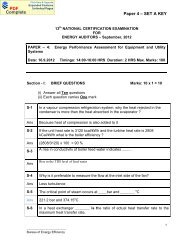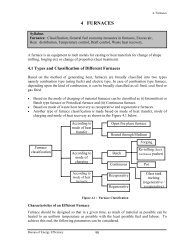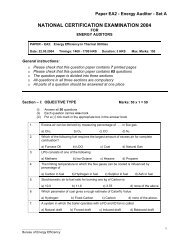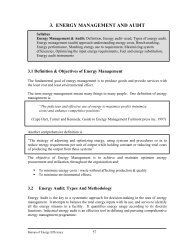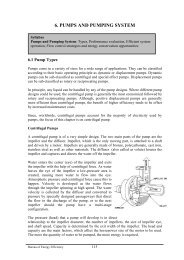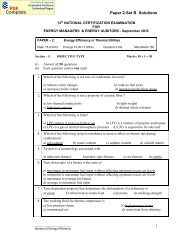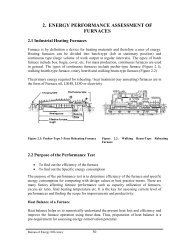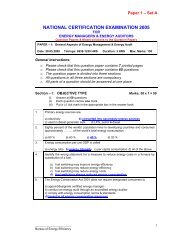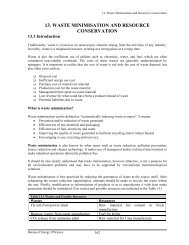Set B - National Certification Examination for Energy Managers and ...
Set B - National Certification Examination for Energy Managers and ...
Set B - National Certification Examination for Energy Managers and ...
Create successful ePaper yourself
Turn your PDF publications into a flip-book with our unique Google optimized e-Paper software.
PDF<br />
Documents<br />
Complete<br />
Click Here & Upgrade<br />
Exp<strong>and</strong>ed Features<br />
Unlimited Pages<br />
13 th NATIONAL CERTIFICATION EXAMINATION<br />
FOR<br />
ENERGY AUDITORS – September, 2012<br />
Paper -4 <strong>Set</strong> B Solutions<br />
PAPER – 4: <strong>Energy</strong> Per<strong>for</strong>mance Assessment <strong>for</strong> Equipment <strong>and</strong> Utility<br />
Systems<br />
Date: 16.9.2012 Timings: 14:00-16:00 HRS Duration: 2 HRS Max. Marks: 100<br />
Section - I: BRIEF QUESTIONS Marks: 10 x 1 = 10<br />
(i) Answer all Ten questions<br />
(ii) Each question carries One mark<br />
S-1<br />
Ans<br />
A draft system in a boiler which uses both FD <strong>and</strong> ID fan is called…….<br />
Balanced Draft<br />
S-2 In a vapour compression refrigeration system, why the heat rejected in the<br />
condenser is more than the heat absorbed in the evaporator ?<br />
Ans<br />
S-3<br />
Because heat of compression is also added to it<br />
If the unit heat rate is 3191 kcal/kWh <strong>and</strong> the turbine heat rate is 2808<br />
kCal/kWh what is the boiler efficiency ?<br />
Ans (2808/3191) x 100 = 88 %<br />
S-4 A rise in conductivity of boiler feed water indicates ____ .<br />
Ans<br />
Rise in the TDS level of feed water<br />
S-5 Why is it preferable to measure the flow at the inlet side of the fan?<br />
Ans<br />
Less turbulence<br />
S-6 The critical point of steam occurs at ____bar <strong>and</strong> _______ o C<br />
Ans<br />
221.2 bar <strong>and</strong> 374.15 o C<br />
S-7 In a heat exchanger _______ is the ratio of actual heat transfer rate to the<br />
maximum heat transfer rate.<br />
___________________________<br />
Bureau of <strong>Energy</strong> Efficiency
PDF<br />
Documents<br />
Complete<br />
Click Here & Upgrade<br />
Exp<strong>and</strong>ed Features<br />
Unlimited Pages<br />
Ans<br />
Effectiveness<br />
S-8 If the In an integrated steel plant pig iron is produced from _________furnace?<br />
Ans<br />
Blast furnace<br />
S-9 PLF of a 210 MW power plant is 85% , what is the annual gross generation in<br />
MWh<br />
Ans<br />
S-10<br />
Ans<br />
1,563,660 MWH<br />
A pump operates on water with a total head of 10 m. If water is replaced by<br />
ethylene glycol with a specific gravity of 1.12 what will be the total head<br />
developed by the pump ?<br />
10 m<br />
. End of Section - I .<br />
Section - II: SHORT NUMERICAL QUESTIONS Marks: 2 x 5 = 10<br />
(i) Answer all Two questions<br />
(ii) Each question carries Five marks<br />
L-1 Calculate pressure drop in meters when pipe diameter is increased from 250<br />
mm to 300 mm <strong>for</strong> a length of 600 meters. Water velocity is 1.5 m/s in the 250<br />
mm diameter pipe <strong>and</strong> friction factor is 0.005 <strong>for</strong> both the pipes.<br />
Ans Pressure drop = 4fLV 2<br />
--------------<br />
2gD<br />
Velocity of water in pipe of 300 mm diameter = (0.25 x 0.25 x 1.5) /(0.3 x 0.3)<br />
= 1.04 m/s<br />
Pressure drop with 300 mm = 4 x 0.005 x 600 x 1.04 2 / (2 x 9.81 x 0.300)<br />
= 2.2 m<br />
L-2 A three phase 37 kW four pole induction motor operating at 49.8 Hz is rated <strong>for</strong> 415<br />
V, 50 Hz <strong>and</strong> 1440 RPM. The actual measured speed is 1480 RPM. Find out the<br />
percentage loading of the motor if the voltage applied is 410 V.<br />
Ans % Loading = Slip x 100%<br />
(Ss – Sr) x (Vr / V) 2<br />
___________________________<br />
Bureau of <strong>Energy</strong> Efficiency
PDF<br />
Documents<br />
Complete<br />
Click Here & Upgrade<br />
Exp<strong>and</strong>ed Features<br />
Unlimited Pages<br />
Synchronous speed = 120 x 49.8 / 4 = 1494 rpm<br />
Slip = Synchronous Speed – Measured speed in rpm.<br />
= 1494 – 1480 = 14 rpm.<br />
% Loading = 14 x 100% = 25.8 %<br />
(1494 - 1440) x (415/410) 2<br />
. End of Section - II .<br />
Section - III: LONG NUMERICAL QUESTIONS Marks: 4 x 20 = 80<br />
(i) Answer all Four questions<br />
(ii) Each question carries Twenty marks<br />
N-1 KEY<br />
a) Theoretical air required <strong>for</strong> complete combustion<br />
⎧ ⎛ ⎛ O2<br />
⎞⎞⎫<br />
( 11.6 x C)<br />
+ ⎨34.8<br />
x ⎜ H<br />
2<br />
− ⎜ ⎟⎟⎬<br />
+ S<br />
8<br />
=<br />
⎩ ⎝ ⎝ ⎠⎠⎭<br />
100<br />
⎧ ⎛ ⎛ 32.52⎞⎞⎫<br />
( 11.6 x 33.95) + ⎨34.8<br />
x ⎜5.01<br />
− ⎜ ⎟⎟⎬<br />
+ ( 4.35 x 0.09)<br />
=<br />
⎩ ⎝ ⎝ 8 ⎠⎠⎭<br />
100<br />
( 4.35 x )<br />
= 4.27 kg / kg of paddy husk<br />
⎛ 77 ⎞<br />
4.27×<br />
⎜ ⎟<br />
⎝ 100 ⎠ ⎛ 0.0091⎞<br />
Moles of N 2 = + ⎜ ⎟<br />
28 ⎝ 28 ⎠<br />
= 0.1178<br />
% CO 2 theoretical =<br />
Moles of<br />
N<br />
Moles of C<br />
+ Moles of C<br />
2 +<br />
Moles of S<br />
___________________________<br />
Bureau of <strong>Energy</strong> Efficiency<br />
⎛ 0.3395 ⎞<br />
⎜ ⎟<br />
= ⎝ 12 ⎠<br />
⎛ 0.3395 ⎞ ⎛ 0.0009⎞<br />
0.1178 + ⎜ ⎟ + ⎜ ⎟<br />
⎝ 12 ⎠ ⎝ 32 ⎠
PDF<br />
Documents<br />
Complete<br />
Click Here & Upgrade<br />
Exp<strong>and</strong>ed Features<br />
Unlimited Pages<br />
Max theoretical ( CO 2 ) t = 19.36 %<br />
Actual CO 2 measured in flue gas = 14.0%<br />
b) % Excess air supplied =<br />
7900 x [(CO<br />
(CO<br />
2<br />
)<br />
a<br />
2<br />
)<br />
− (CO<br />
x [100 − (CO<br />
t<br />
2<br />
2<br />
)<br />
)<br />
t<br />
a<br />
]<br />
= 37.5 %<br />
c) Actual mass of air supplied = {1 + EA/100} x theoretical air<br />
= {1 + 37.5/100} x 4.27<br />
= 5.87 kg/kg of coal<br />
Mass of dry flue gas =<br />
0 .3395 × 44<br />
5.87 × 77 (5.87 − 4.27) × 23<br />
+ 0.0091 + +<br />
12<br />
100<br />
100<br />
= 6.15 kg / kg of coal<br />
(or)<br />
(actual mass of air supplied + 1) – mass of H 2 0<br />
(5.87 + 1) – (9H + M) = 6.87 – (9x.05 + 0.1079)= 6.87 – 0.5579 = 6.31 kg/kg of coal<br />
% Heat loss in dry flue gas =<br />
m x C P x (Tf<br />
− Ta<br />
)<br />
GCV of fuel<br />
x 100<br />
=<br />
6.15 x 0.23 x (140 − 32)<br />
3568<br />
x 100<br />
= 4.28 %<br />
Loss due to CO =<br />
Heat Loss in ash<br />
% heat loss due to unburnt flyash<br />
___________________________<br />
Bureau of <strong>Energy</strong> Efficiency<br />
= 0.35 x 0.3395 x 5654<br />
(0.35+14) x 3568<br />
= 1.31 %<br />
% ash in paddy husk = 16.73<br />
Ratio of bottom ash to flyash = 10:90
PDF<br />
Documents<br />
Complete<br />
Click Here & Upgrade<br />
Exp<strong>and</strong>ed Features<br />
Unlimited Pages<br />
GCV of flyash<br />
= 450 kcal/kg<br />
Amount of flyash in 1 kg of husk = 0.9 x 0.1673<br />
= 0.15 kg<br />
Heat loss in flyash = 0.15 x 450<br />
= 67.5 kcal/kg of husk<br />
GCV of bottom ash<br />
= 800 kcal/kg<br />
Amount of bottom ash in 1 kg of husk = 0.1 x 0.1673<br />
= 0.01673 kg<br />
Heat loss in bottom ash = 0.01673 x 800<br />
= 13.4 kcal/kg of husk<br />
Total heat loss in ash = 67.5 + 13.4<br />
= 80.9 kcal/kg<br />
% loss in ash = 80.9/3568<br />
= 2.26 %<br />
Total losses = 100 – (4.28 + 1.31+2.26) – (14.33)<br />
Boiler efficiency = 100 – 7.85 – 14.33 = 78 %<br />
N-2 KEY<br />
Ans<br />
Hot Water use per day : 20,000 L/day<br />
Water in = 20 0 C<br />
Water out = 60 0 C<br />
Temp. diff. = 40 0 C<br />
Total Heat required<br />
= mCpdt<br />
= 20000 x 1 x 40 = 8,00,000 kcal/day<br />
a) <strong>Energy</strong> Requirement <strong>for</strong> 20KL/day of water <strong>for</strong> a temperature differential of 40<br />
deg.C in an Electric Boiler/Geyser<br />
<strong>Energy</strong> Requirement (<strong>for</strong> 20 KL/day)<br />
= Total heat required (800000)<br />
860 kcal/kWh x 0.99 ( efficiency of electric heating))<br />
= 939.6 kWh/day<br />
b) For 20 KL/day, of water flow with 40 0 C Temperature Diff. <strong>Energy</strong> to be drawn by<br />
Heat Pump<br />
= 8,00,000 = 391.68 Kwh/day<br />
860x0.95x2.5<br />
___________________________<br />
Bureau of <strong>Energy</strong> Efficiency
PDF<br />
Documents<br />
Complete<br />
Click Here & Upgrade<br />
Exp<strong>and</strong>ed Features<br />
Unlimited Pages<br />
<strong>Energy</strong> drawn by circulation pump = 2.8 x 24 hr = 67.2 kWh/day<br />
<strong>Energy</strong> drawn by evaporator fan = 1.4 kW x 16 hr = 22.4 kWh/day<br />
Total <strong>Energy</strong> drawn by heat pump system = 391.68 +67.2+22.4<br />
= 481.28 kWh /day<br />
SAVINGS IN COMPARISON TO ELECTRIC WATER HEATER<br />
= 939.6 – 481.28 = 458.32 Kwh/day<br />
= 1,60,412 kWh/year ( @ 350 days/year)<br />
= 12.83 lakhs ( @ Rs8.0 per kWh)<br />
SIMPLE PAY BACK PERIOD = Rs.16.0 LAKHS Investment/ Rs.12.83 lakhs per<br />
year savings<br />
= 1.25 years or 15 months<br />
N-3 KEY<br />
Ans Power generation from cogen plant = 5000X 0.9 X 8000 = 360 lac Kwh/yr<br />
Auxiliary power = 1%<br />
Net power generation = 0.99 X 360 = 356.4 lac Kwh<br />
Natural gas requirement <strong>for</strong> = 360 X 3050 / 9500 = 115.57 lac sm 3<br />
power generation<br />
Cost of fuel per annum = 115.57 X 8 = Rs.924.56 lacs<br />
Annual expenditure <strong>for</strong> interest, =<br />
depreciation <strong>and</strong> O&M<br />
500 + 200 = 700 lacs<br />
Total cost of generation = Rs.1624.56 lacs.<br />
Cost of cogeneration power = 1624.56 X 10 5 / 356.4 X 10 5<br />
= Rs.4.56 / Kwh.<br />
Gas consumption in existing gas = [10000 (665 – 85) / (0.82 X 9500)]<br />
fired boiler = 744.6 Sm 3 /hr<br />
= 744.6 x 24 = 17870 sm 3 /day<br />
___________________________<br />
Bureau of <strong>Energy</strong> Efficiency
PDF<br />
Documents<br />
Complete<br />
Click Here & Upgrade<br />
Exp<strong>and</strong>ed Features<br />
Unlimited Pages<br />
Cost of steam from existing boiler<br />
= 744.6*Rs. 8 x8000<br />
= Rs. 476.5 Lacs /yr<br />
Cost of power generation after giving = 1624.56 – 476.5 = Rs.1148.06 lacs<br />
credit <strong>for</strong> steam generation<br />
Cost of power generation after accounting = 1148.06 X 10 5 / 356.4 X 10 5<br />
<strong>for</strong> steam cost<br />
= Rs. 3.22 / kWh<br />
Grid power cost = Rs. 4.5 / Kwh<br />
Cost advantage <strong>for</strong> cogen plant = 4.5 – 3.22 = Rs.1.28 / Kwh<br />
generation<br />
Daily gas requirement <strong>for</strong> operating = 5000 X 0.9 X 3050 X 24<br />
GT cogen plant 9500<br />
= 34673.68 Sm 3 / day<br />
Additional gas requirement <strong>for</strong> = 34673.68 – 17870 = 16803.68 Sm 3 /day<br />
co-gen plant<br />
N-4 To attempt ANY ONE OF THE FOLLOWING among A, B, C <strong>and</strong> D<br />
N4A<br />
KEY<br />
Ans i) Turbine power output kW =<br />
Steam flow to turbine kg/hr x enthalpy drop across the turbine kcal/kg<br />
-------------------------------------------------------------------------------------------------------<br />
860<br />
Inlet enthalpy of steam<br />
=794.4 kcal/kg<br />
Enthalpy of exhaust steam is calculated as given below<br />
exhaust steam dryness fraction = 90%<br />
enthalpy of exhaust steam = (45.9 + 0.9 x 572.5) = 561 kcal/kg<br />
turbine output = ((120 x 1000 kg/hr x (794.4 – 561) kcal/kg) /860<br />
turbine output = 32567.4 kW<br />
ii) generator output kW = turbine output x combined efficiency of mechanical, gear<br />
transmission & generator<br />
= 32567.4 x 0.92<br />
=29962 kW<br />
iii) turbine heat rate = heat input in to the turbine/ generator out put<br />
=q x (h1 – hw)/generator out put<br />
___________________________<br />
Bureau of <strong>Energy</strong> Efficiency
PDF<br />
Documents<br />
Complete<br />
Click Here & Upgrade<br />
Exp<strong>and</strong>ed Features<br />
Unlimited Pages<br />
Where<br />
q = steam inflow to turbine kg/hr<br />
h1= enthalpy of turbine inlet steam =794.4 kcal/kg<br />
hw= enthalpy of feed water to boiler = 100 kcal/kg<br />
Turbine heat rate = ((120 x 1000 kg/hr) x (794.4 – 100) kcal/kg))/ 29962 kw<br />
= 2781 kcal/kwh<br />
iv) unit heat rate = turbine heat rate /boiler efficiency<br />
= 2781 / 0.88 = 3160 kcal/ kwh<br />
3 Marks<br />
v) turbine cycle efficiency = (860 / turbine heat rate) x 100<br />
= 860 /2781 =0.309<br />
=0.309 x 100 = 30.9%<br />
vi) condenser heat load = m x cp x dt<br />
Where m = cooling water flow through condenser, kg/hr<br />
note: density of water is given as 0.95 g /cubic centimetre = 950 kg/ cubic meter<br />
cp = specific heat of cooling water, kcal/ kg. o C = 0.98 kcal /kg. o C<br />
dt = cooling water temperature rise, o C = 10<br />
Condenser heat load =6318 x 950x 0.98 x 10 = 5,88,20,580 kcal /hr<br />
vii) specific steam consumption of turbine = 860 / (enthalpy drop x combined efficiency)<br />
= 860/ ((794.4 – 561) x 0.92))<br />
=860 / (233.4 x 0.92) =4.0 kg/kwh<br />
= 4.0 kg / kwh<br />
N4B<br />
Ans<br />
KEY<br />
Volumetric flow rate of PH gas at NTP = 1.47 x 125 x 1000 = 183750<br />
[Nm3/hr]<br />
Mass flow rate of PH gas = 183750 x 1.42 = 260925 [kg/hr]<br />
Calculation <strong>for</strong> 4 stage pre-heater kiln<br />
Heat loss in PH Gas = m x cp x T [kcal/hr]<br />
= 260925 x 0.244 x 370 = 23556309 [kcal/hr]<br />
Equivalent coal wasted =<br />
23556309<br />
5540 Χ1000<br />
= 4.252 [tons of coal/hr]<br />
Electrical <strong>Energy</strong> consumption of PH Fan<br />
___________________________<br />
Bureau of <strong>Energy</strong> Efficiency
PDF<br />
Documents<br />
Complete<br />
Click Here & Upgrade<br />
Exp<strong>and</strong>ed Features<br />
Unlimited Pages<br />
Volumetric flow rate of PH Gas at 370 o C temperature <strong>and</strong> -400 mm WC static pressure:<br />
V<br />
=<br />
(273 + 370) Χ10333<br />
183750 Χ = 450216 [m3/hr]<br />
273 Χ 10333 − 400<br />
( )<br />
or V = 450216/3600 = 125 [m3/sec]<br />
Pressure difference across PH fan = 50 – (- 400) = 450 [mm WC]<br />
Power consumption of PH fan<br />
125 Χ 450<br />
P =<br />
= 806.24 [kW]<br />
102 Χ 0.72 Χ 0.95<br />
Calculation <strong>for</strong> 6 stage pre-heater kiln<br />
Heat loss in PH Gas = m x cp x T [kcal/hr]<br />
= 260925 x 0.244 x 295 = 18781381 [kcal/hr]<br />
Equivalent coal wasted =<br />
18781381<br />
5540 Χ1000<br />
= 3.39 [tons of coal/hr]<br />
Electrical <strong>Energy</strong> consumption of PH Fan<br />
Volumetric flow rate of PH Gas at 295 o C temperature <strong>and</strong> -600 mm WC static pressure:<br />
V = (273+<br />
295) Χ10333<br />
183750Χ = 405875 [m 3 /hr]<br />
273Χ<br />
( 10333−<br />
600)<br />
Or V = 405875/3600 = 112.75 [m 3 /sec]<br />
Pressure difference across PH fan = 50 – (- 600) = 650<br />
[mm WC]<br />
Power consumption of PH fan<br />
P = 112.75 Χ 650 = 1050.4 [kW]<br />
102 Χ 0.72 Χ 0.95<br />
The above kilns can be compared as follows:<br />
Item<br />
6 Stage PH 4 stage PH kiln<br />
Kiln<br />
PH Gas heat loss (kcal/hr) 18781381 23556309<br />
Equivalent coal wasted (tons of coal) 3.39 4.252<br />
Power consumption in PH Gas (kW) 1050 806.24<br />
Calculation <strong>for</strong> annual Monetary savings<br />
Coal savings in 6 stage PH Kiln = 4.252 – 3.39 = 0.862 [ton of coal/hr]<br />
Annual monetary savings (Thermal) = 0.862 x 8000 x 6150 = 4,24,10,400 [Rs.]<br />
Additional Electrical energy requirement <strong>for</strong> 6 stage PH Kiln = 1050.4 – 806.24 = 244.16<br />
[kW]<br />
Annual additional electrical cost = 244.16 x 8000 x 5 = 97,66,400 [Rs.]<br />
It is obvious that in monitory terms, thermal energy saving in 6 stage pre-heater kiln is higher than the additional<br />
electrical energy cost in 4 stage kiln. There<strong>for</strong>e, 6 stage pre-heater kiln is better option than 4 stage pre-heater<br />
___________________________<br />
Bureau of <strong>Energy</strong> Efficiency
PDF<br />
Documents<br />
Complete<br />
Click Here & Upgrade<br />
Exp<strong>and</strong>ed Features<br />
Unlimited Pages<br />
kiln.<br />
So the net annual monetary saving in case of 6 stage pre-heater kiln is<br />
= 4,24,10,400 – 97,66,400 = 3,26,44,000 [Rs.]<br />
N4C<br />
KEY<br />
Ans a)<br />
Be<strong>for</strong>e insulation<br />
Surface heat loss, S = [ 10 + (TS-Ta)/20] x (Ts –Ta)<br />
Total heat Loss = S x A where A= Surface area, m 2<br />
Surface heat loss , S = [ 10 + ( 110-25)/20] x (110-25) = 1211.25 K.Cal/m 2 /hr<br />
Total heat loss = 1211.25 x 20 m 2 = 24225 kCal/hr<br />
After insulation<br />
Surface heat loss ,S = [ 10 + (55-25)/20] x (55-25) =345 K.Cal/m 2 /hr<br />
Total heat loss = 345 x 20 m 2 = 6900 kCal/hr<br />
Heat reduction per hour after proper insulation = 24225- 6900 = 17325 kCal/hr<br />
Annual heat loss reduction = 17325 x 8000 = 138600000<br />
= 138.6 million kCal/year<br />
Steam distribution loss = 20%<br />
Heat loss<br />
= 138.6 million kCal/ 0.8 = 173.25 million kcal/year<br />
Boiler efficiency = 70%<br />
Equivalent coal consumption reduction = 173.25 x10 6 /0.7 x 4800 = 51.56 Ton /year<br />
Monetary Cost savings per year = 51.5 x 5000 = Rs 2.575 lacs<br />
Investment @ Rs 1000 per M 2 = 20 x 1000 = Rs 20000<br />
Condensate recovery<br />
Reduction in coal consumption through<br />
heat recovered from condensate return = 2000 x 1 x (80 – 40) / 0.7 x 4800<br />
= 23.8 kg of coal per hour<br />
Annual coal savings = 23.8 x 8000/1000<br />
= 190.4 ton / year<br />
Annual savings<br />
= 23.8 x 8000 x Rs.5/kg coal<br />
= Rs. 9.52 lacs<br />
b)Simple payback period<br />
Total savings from both the measures = 2.575 + 9.52 = 12.1 lakhs<br />
Total investment = Rs. 20,000 + Rs 2 lakhs = Rs.2.2 lakhs<br />
Simple payback period (combined) = 2.2/12.1= 2.2 months<br />
c)GHG emission reduction<br />
Carbon content in the coal<br />
___________________________<br />
Bureau of <strong>Energy</strong> Efficiency<br />
= 40% by weight
PDF<br />
Documents<br />
Complete<br />
Click Here & Upgrade<br />
Exp<strong>and</strong>ed Features<br />
Unlimited Pages<br />
Total Coal saving /year<br />
CO 2 reduction<br />
= 51.5 + 190.4 = 241.9 Ton per year<br />
= 241.9 x 0.4 x 44/12 = 355 Ton of CO 2 /year<br />
N4D<br />
Ans<br />
KEY<br />
Theoretical air required <strong>for</strong> complete combustion<br />
=[(11.6x85.9)x(34.8x(12-0.7/8))+4.35x0.5]/100<br />
=996.44+414.12+2.175/100<br />
=14.1 kg/kg of oil<br />
Existing oxygen % in flue gas =6%<br />
% excess air supplied =6 x100/(21-6) =40%<br />
Actual mass of air supplied =(1+Excess air/100)x Theoretical air<br />
=(1+40/100)x 14.1<br />
=19.74 kg/kg of oil<br />
After modification, oxygen % in flue gas =3%<br />
% excess air supplied =3 x100/(21-3) =16.67%<br />
Actual mass of air supplied<br />
=(1+Excess air/100)x Theoretical air<br />
=(1+16.67/100)x 14.1<br />
=16.45 kg/kg of oil<br />
a) Heat loss reduction through actual mass of air supplied<br />
Actual mass of air supplied be<strong>for</strong>e WHR =19.74 kg/kg of oil<br />
Actual mass of air supplied AFTER WHR =16.45 kg/kg of oil<br />
Existing oil consumption per hour = 25 ton/hr x 60kg/ton = 1500 kg of oil /hr<br />
Flue gas loss be<strong>for</strong>e WHR = [1500 kg oil + (1500 x 19.74 kg air)] x 0.24 x (600-30)<br />
= 4255848 kcal/hr<br />
Flue gas loss after WHR = [1500 kg oil + (1500 x 16.45 kg air)] x 0.24 x (300-30)<br />
= 1696140 kcal/hr<br />
Flue gas heat loss reduction after WHR implementation = 4255848-1696140<br />
= 2559708 kcal/hr<br />
Reduction in fuel oil consumption after installing<br />
Waste heat recovery <strong>and</strong> reduction in excess air<br />
= 256 kg/hr<br />
Furnace efficiency after WHR = 25000 x 0.12 x (1200-40) x 100<br />
___________________________<br />
Bureau of <strong>Energy</strong> Efficiency
PDF<br />
Documents<br />
Complete<br />
Click Here & Upgrade<br />
Exp<strong>and</strong>ed Features<br />
Unlimited Pages<br />
= 28 %<br />
[(1500-256) x10000)]<br />
b) Calculate fuel oil reduction after charging hot ingot in reheating furnace<br />
Ingot charging temperature is increased from 40 o C to 500 o C<br />
Fuel oil reduction due to increased charge temperature =<br />
= 25 x 1000 x 0.12 x(500-40)/0.28 x10,000<br />
= 492.86 kg/hr = 493 kg/hr<br />
c ) Specific oil <strong>and</strong> power consumption after implementing both the above measure<br />
Fuel oil reduction after implementation of both measures<br />
= 256 + 493 = 749 kg oil/hr<br />
Fuel oil consumption after implementation of both measures<br />
= 1500 – 749 = 751 kg oil/hr<br />
Yield improvement = 3%<br />
Production after implementation = 25 x 1.03 = 25.75 ton/hr<br />
of both measures<br />
Specific oil consumption<br />
Specific power consumption<br />
= 751/ 25.75 = 29.2 kg/Ton<br />
= 25x90 / 25.75 = 87.37 kWh/ton<br />
-------- End of Section - III ---------<br />
___________________________<br />
Bureau of <strong>Energy</strong> Efficiency



